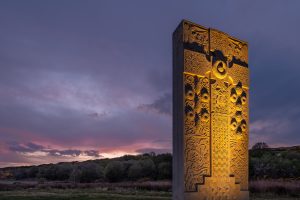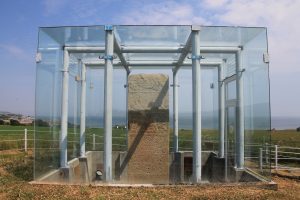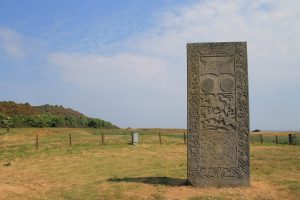MORE FROM SCOTLAND MAGAZINE
Easter Ross: A Highland secret
Characterised by abundant farmland and the water that encloses it, Easter Ross is a region rich in history that rewards time and exploration
Words by Emma Gibbs
The low-lying, gently rolling farmland of Easter Ross is so classically bucolic – and so strikingly different to the drama that many of us associate with the Highlands – that you’d be forgiven for wondering if you’d accidentally turned south at Inverness and ended up in the Borders instead.
Unlike the Lowlands, further south, however, here the promise of mountains never seems far away; you’ll catch a glimpse of them in your rear-view mirror as the road cuts through green fields, or as you look out across one of the region’s three firths.
It is these sea inlets that dominate the geography of this region; even from the main road, the A9, the water is always nearby. Stretching from North Kessock, directly opposite Inverness, to the small but historic town of Tain, Easter Ross encompasses two peninsulas that jaggedly jut out into the Moray, Cromarty and Dornoch firths: the Black Isle to the south, which, despite its name, is neither black in colour nor an island and the Easter Ross Peninsula to the north.
Both are home to patchworks of farms, fishing villages like Cromarty, where old fishermen’s cottages nestle against grand merchants’ houses, and shallow curves of pale golden sand that you’ll often have to yourself.

In addition, the waters here are home to the most northerly population of bottlenose dolphins, who are also the largest of their kind, thanks to the particularly thick layer of blubber they’ve evolved to keep them warm in the cold waters of the Moray Firth.
Inland, off the busy A9, the orderly little village of Evanton is the starting point for a peaceful walk through towering community woodland to the forbidding, steep-sided Black Rock Gorge, used as a location in Harry Potter and the Goblet of Fire. A little further north of here lies Loch Glass, which lives up to its name on the calmest of days and is overlooked by the sprawling hulk of Ben Wyvis.
But perhaps the real drama of the region lies in what is less known; in particular, the many carved stones left behind by the Picts, who lived in northern Scotland from AD300 to AD900. Little is known about these people, but it is generally accepted that the vast majority were farmers who kept livestock like cattle, pigs, and sheep. With its microclimate that makes it drier and milder than much of the rest of the Highlands, Easter Ross remains one of Scotland’s best agricultural areas today.
“The Picts left behind a rich legacy in Easter Ross,” says Alastair Morton, Trustee of Groam House Museum in the seaside village of Rosemarkie on the Black Isle.

“Here you’ll find, in my opinion, the most sophisticated and artistically accomplished Pictish sculptures.”
Indeed, this claim is immediately backed up by a visit to the museum, which, despite its diminutive external appearance, is like stepping into a Pictish treasure trove, so crammed is it with remnants of their artistry. Pride of place is given to the Rosemarkie cross-slab, thought to have been made for the village’s early Christian monastic site in the late 700s and which, with its incredible intertwining decorations and symbols, shows the complexity of this period’s art. Perhaps most astonishing is the fact that all the carved stones here – and there are many – were found within just 200m of the museum.
Similarly impressive is the collection at Tarbat Discovery Centre in the pretty, whitewashed village of Portmahomack on the hammer-shaped Easter Ross Peninsula. Set in an old church that was built on the remains of a Pictish monastery, the over 200 pieces of Pictish sculpture that were found here illustrate the flourishing settlement it once would have been. “There was a time during the 1997 excavation,” Tarbat Discovery Centre’s volunteer coordinator, Mary Fleming, says, “when every excavation would find yet another piece of Pictish art. It was astounding.”

These insightful small museums provide an illuminating introduction to the carved stones left behind by the Picts, but to really contemplate their mystery properly, they need to be seen in situ.
Arguably the region’s best example is the Shandwick Stone, standing in a field above the golden swathe of Shandwick Bay, at the southern end of the so-called ‘Seaboard Villages’ on the Easter Ross Peninsula’s eastern coast.
Although it’s now protected by a glass case, this does little to diminish the beauty of this cross-slab, which is decorated on one side by an ornate Christian cross (the Picts had all largely converted to Christianity by the seventh century) and on the other with a busy hunting scene. It’s staggering to contemplate the age, beauty and craftsmanship of its art, with the firth shimmering beyond just as it would have done when the stone was erected here in AD780.

Other stones can be seen at nearby Hilton (a full-size but highly effective replica of the Cadboll Stone), in a graveyard in Edderton near Tain, and tucked inside the pretty church at Nigg, near the peninsula’s southern tip.
Many of these stones repeat the same symbols: crescents with V-shaped rods; boars; serpents and lions; and geometric patterns. They reflect the skill of the Picts, but also the lives that they led – their worship of a Christian god, their hunting, and their farming. So, while little else may remain of this period of history, the continuing existence of these stones helps to anchor the Picts to the region as we can see and experience it today.

It’s not hard to see why the Picts thrived here in this abundant landscape, nor why communities continue to flourish within it. Neither is it hard to fall for the quiet, understated drama of Easter Ross, once you’ve taken the time to uncover it.
This is an extract. Read the full version in our November/December 2023 issue. Available to buy from Friday 13 October here.

SCOTLAND MAGAZINE
Published six times a year, every issue of Scotland showcases its stunning landscapes and natural beauty, and delves deep into Scottish history. From mysterious clans and famous Scots (both past and present), to the hidden histories of the country’s greatest castles and houses, Scotland‘s pages brim with the soul and secrets of the country.
Scotland magazine captures the spirit of this wild and wonderful nation, explores its history and heritage and recommends great places to visit, so you feel at home here, wherever you are in the world.












